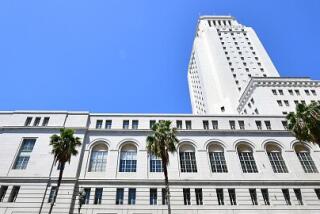Council’s Mask of Casualness Hides Tension
- Share via
A visitor might think that a Los Angeles City Council meeting is not a place where serious work is done.
Council members give scrolls to winning high school athletic teams and championship garden clubs. On a recent Tuesday, the king and queen of Spain dropped in, prompting a two-hour break from the monotony of zoning and appropriations. On most days, the lawmakers restlessly stroll about, exchanging gossip with reporters whose desks are on the sidelines or conferring with lobbyists who stand on the other side of blue rope barriers. A telephone, placed carelessly near eavesdropping reporters’ desks, brings members news from friends, constituents, family members or, on occasion, a stockbroker.
But all this casualness masks the true state of affairs. Today, beneath the glad-handing, the City Council chamber is tense and unpredictable. It is, in fact, an arena of clashing ideologies and ambitions where it is hard to predict how the council will decide on major policy issues such as growth and deteriorating housing in poor neighborhoods. But none of this is apparent unless visitors understand the game and the players.
For example, those two councilmen deep in conversation near the back exit aren’t as chummy as they look. The man in the blue blazer, either made or inspired by Brooks Bros., is Zev Yaroslavsky. His companion is former Assemblyman Richard Alatorre, also wearing a stylish outfit, one reminiscent of his mentor, the well-turned-out Speaker of the Assembly, Willie Brown.
Yaroslavsky, raised in the stiletto style politics of the Westside, and Alatorre, who sledgehammered his way through the Eastside’s street-tough political life, are career rivals. Both would like to be mayor, and their ambition and skill are also factors in the council’s unsettled condition. Until their fast tracks converge for the big one, they test each other, playing the game at a higher and more sophisticated level than most of their colleagues, comparable to the difference between the chess players in a world class match and those at Venice Beach.
The contest erupts at unexpected times in subtle ways. One day the council Finance Committee was debating the cost of beautifying the downtown Central Library, soon to be rebuilt. Neither Yaroslavsky nor Alatorre is known as a connoisseur of urban design. But when Yaroslavsky, in a sharp attack, said costs were out of line, Alatorre, clearly unwilling to let his rival hog the spotlight, sided with the library designers. The argument was not really about design or costs but who would prevail. The result, however, was that the library designers got an unexpected ally in Alatorre.
The newcomers also have made the council unpredictable: Gloria Molina, smart and strong enough to have successfully stood up to Speaker Brown when she was an assemblywoman; Ruth Galanter, quiet, avoiding public controversy as she pursues a slow-growth agenda; Nate Holden, alone and glowering in the role he has created for himself, the angry outsider.
The swiftness of ethnic change has weakened two veterans. With his once solidly black district growing more Latino and Asian--and more volatile--Robert Farrell is facing a recall. Veteran Gilbert Lindsay, the City Council’s first black member, is 86 and bewildered by the new political currents, ethnic groups and grass-roots organizations in a district that once was a stable combination of downtown high-rises, industry and politically placid poor blacks. While assistants help him follow the agenda, the downtown business executives, who have financed his campaigns and received his support for their projects, wonder what will happen when he leaves.
The 15-member council is a much more interesting place than it was a few years ago when it was dominated by men who resembled small town retailers. Even today, there is a lot of the Dinuba Rotary Club about council meetings, especially on Fridays when scrolls are handed out.
But that is the past. The game now is the future. The City Council is mirroring the unpredictable tensions on the streets of Los Angeles, the result of a membership that increasingly reflects the city’s economic and ethnic diversity.
More to Read
Sign up for Essential California
The most important California stories and recommendations in your inbox every morning.
You may occasionally receive promotional content from the Los Angeles Times.













